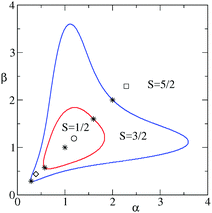Comment on “Magnetostructural correlations in isolated trinuclear iron(III) oxo acetate complexes” by J. Lang, J. M. Hewer, J. Meyer, J. Schuchmann, C. van Wüllen and G. Niedner-Schatteburg, Phys. Chem. Chem. Phys., 2018, 20, 16673
Michał
Antkowiak
 *,
Grzegorz
Kamieniarz
*,
Grzegorz
Kamieniarz
 and
Wojciech
Florek
and
Wojciech
Florek

Faculty of Physics, A. Mickiewicz University in Poznań, ul. Umultowska 85, 61-614 Poznań, Poland. E-mail: antekm@amu.edu.pl
First published on 3rd December 2018
In a recent paper1 by Lang et al. the correlations between geometric triangular structures and antiferromagnetic coupling in four trinuclear s = 5/2 iron complexes are revealed by some experiments and B3LYP level DFT calculations. The complexes differ in the number of pyridine ligands coordinated which in turn affects the interactions within the metallic iron cores. Referring to a spin Heisenberg model, switching of magnetic ground states is realized due to different numbers of pyridines bonded. However, the phenomenological aspect of the work contains some features which deserve some amendments and further investigation.From the primary assumption1 that the orbital momentum can be neglected for the d5 Fe ions, the magnetism originates purely from the spin degrees of freedom. Without spin–orbit coupling they cannot affect the geometric structure despite some claims provided.1 Instead, the spins located in the triangular geometry are subject to geometrical frustration and their total spin ground state depends on the relative strength of the interactions involved. Moreover, any triangular architecture with antiferromagnetic coupling fulfils the condition of bipartiteness in the sense of the Lieb–Mattis theorem.2,3 This statement was demonstrated for the isosceles triangle2,3 and can be generalized to the scalene triangle geometries. Bipartiteness entails that for uniform spins s located at the vertices of any triangle, the total spin S in the ground state is bounded by the constraint S ≤ s.
Defining the size of a chosen edge of the scalene triangle |J*| = 1 and the remaining ratios α = J1/J* and β = J2/J*, the ground state diagram is determined for the local spin s = 5/2 and plotted in Fig. 1. The asterisks show the exact critical values along the α = β line2,3 which correspond to the appropriate crossing points1 occurring in Fig. 5, whereas the remaining symbols represent the coordinates of the complexes in question.1 The continuous lines demonstrate the Kahn degenerate frustration points.2,3 We note that for the isosceles triangle system with arbitrary uniform values of the local spin s, there exist 2s critical values αc given by the coordinates: 2 + (1 − j)/s for 1 ≤ j ≤ ⌊s⌋; 1 for any half-integer s; and 2 − (1 + j)/(s + 1) for ⌈s + 1⌉ ≤ j ≤ 2s, where the appropriate mathematical symbols are exploited.
 | ||
| Fig. 1 Ground state diagram for three local spins s = 5/2 showing the areas corresponding to the total spin S in the α and β plane in agreement with the Lieb–Mattis theorem. | ||
In summary, the original findings for the complexes have broader theoretical context and provide further experimental confirmation of the fundamental Lieb–Mattis theorem.
Conflicts of interest
There are no conflicts to declare.References
- J. Lang, J. M. Hewer, J. Meyer, J. Schuchmann, C. van Wüllen and G. Niedner-Schatteburg, Phys. Chem. Chem. Phys., 2018, 20, 16673–16685 RSC.
- G. Kamieniarz, W. Florek and M. Antkowiak, Phys. Rev. B: Condens. Matter Mater. Phys., 2015, 92, 140411 CrossRef.
- W. Florek, M. Antkowiak and G. Kamieniarz, Phys. Rev. B, 2016, 94, 224421 CrossRef.
| This journal is © the Owner Societies 2019 |
